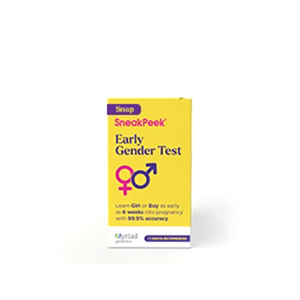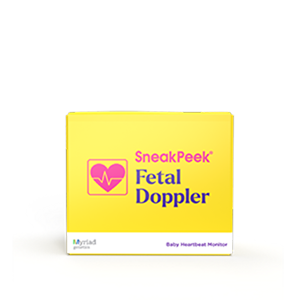Published on January 7th, 2022 and Updated on January 12th, 2024
Check out SneakPeek Gender Test to find out your baby’s gender as early as 6 weeks at over 99% accuracy1!
What’s better than snuggling into a downy pillow at the end of a long day? How about snuggling into a mountainous heap of pillows at the end of a long day? As an adult, you’ve got so many to choose from: lumbar, Euro, U-shaped, gel, foam, kapok—well, you get the idea.
But not a single one of these pillows is suitable for your baby. At least not right away. So, when can baby have a pillow? And can baby sleep too much?
Although you can dive into a veritable buffet of contours, materials, and wedges, your precious little burrito won’t be ready for her first pillow for at least one year. In this guide, we’ll explain why waiting a year to introduce pillows is important, how to know when your baby is ready to snuggle up to her own pillow, and what you can do to ensure her sleep is comfy and cozy until then.
Pillows and Baby Sleep Safety
Sleep safety is a paramount concern for parents. From selecting the right crib to choosing the best temperature for baby sleep, parents must make a cascade of decisions regarding where and how their newborn sleeps.
Unlike picking Silvermist or Tidewater for the hue of the nursery room walls, some choices surrounding baby’s sleep environment have crucial implications.
The American Academy of Pediatrics (AAP), a nationally respected physicians’ group committed to the optimal wellbeing of children, warns that every year around 3,400 babies in the U.S. die while sleeping due to accidental suffocation, strangulation, or sudden infant death syndrome (SIDS)—the unexpected death of an infant from unknown causes.
To reduce the risk of sleep-related death and injury, the AAP recommends:
- Babies should sleep on their backs until their first birthday to ensure their airways don’t become blocked by the surface of the mattress.
- Crib and bassinet mattresses should be gapless to reduce the risk of baby’s arms or legs getting stuck between the mattress and the crib.
- Mattress sheets should be tightly fitted and secured to make sure baby doesn’t become tangled in them.
- Baby should be properly dressed in a swaddle or wearable blanket if needed to make sure she stays warm during the night.
- Nothing that could be a potential choking or strangulation hazard should be placed in the crib with baby, including:
- Toys
- Bumpers
- Quilts
- Blankets
- And, you guessed it, pillows
It might seem that without pillows and blankies, your sweetpea’s crib is minimalist as a plain white onesie. Stll, it’s crucial to resist the urge to decorate with pillows, loose bedding, or any item that could increase the risk of entrapment or suffocation.
But don’t worry! This spartan crib decor won’t last long.
When is baby ready for a pillow?
As is true for many childhood milestones, the answer to when your baby will be ready for a pillow depends entirely on his individual development.
Admittedly, this answer is as opaque and mushy as mashed bananas. However, experts agree that a pillow should never be used for a child under one year old.
There is wiggle room between the one-year mark recommended by the Consumer Product Safety Commission and the two-year mark recommended by the American Academy of Pediatrics. In this matter, consider consulting your family pediatrician for their personal recommendation and guidance.
A couple of factors your pediatrician will consider prior to giving you a thumbs up on your baby’s pillow use include:
- Age after the 12-month mark – Your child should have at least celebrated his first birthday before snuggling up to a pillow, as the risk of suffocation or SIDS decreases dramatically after children pass the 12-month mark. This is partially because of their increased muscle strength, which allows them to lift their heads when on their stomachs (to prevent suffocation against surfaces like pillows). So, your pediatrician will consider your child’s specific age after 12 months.
- Ability – Remember how we talked about increased muscle strength? As your child grows, he’ll continue to develop muscle strength, control, and coordination, so your pediatrician will assess his unique agility level to ensure he’s able to effectively navigate his crib and any accessories that may be added to it.
Another factor you can take into account when determining the best time to introduce a pillow to your little snoozer? Personal preference.
Developmentally speaking, there’s no reason for your child to need a pillow, and some adults prefer not to use a pillow at all. Similarly, some children prefer the flat, solid surface that a crib mattress (or regular mattress) provides.
So, if your child isn’t tossing or turning with discomfort during the night, you don’t have to worry about giving him a pillow just yet.
How to Ensure a Comfy Sleep Environment Until She’s Ready for a Pillow
On those nights when you find yourself crawling out of your baby’s room to keep her from waking up, only to hear her crying before you even reach the door, you may feel inclined to surround her in the plush comfort of pillows to help her feel like she’s sleeping on a cloud.
There are many ways to make your baby’s crib and surrounding sleep environment an ideal snooze haven, while maintaining her safety. Let’s look at the top three.
#1 Choose the Right Location
According to the AAP, it’s best to share a room with your young baby until she reaches one year old. However, the AAP also makes clear that this doesn’t mean you should share your bed with your baby.
Instead, your little cherub’s crib or bassinet should be kept close to your bed, but completely separate and detached. This turns her sleep environment into a snooze haven in two ways:
- Your little one knows that you’re in the room with her, so she can feel calmed by your presence (and you can avoid having to sneak out on all fours).
- You’re able to quickly and easily change or feed her during the night, so any issues that would make sleep uncomfortable (i.e. a dirty diaper or a grumbly tummy) are quickly resolved.
#2 Pick Out the Perfect PJs
Even if the weather is chilly, your baby doesn’t need a blanket, quilt, or comforter to stay warm. If she’s younger than 2 months, you can simply swaddle your baby in the warm embrace of a baby blanket.
If your little one is over 2 months old and has learned to roll over onto her tummy, swap the swaddle for a seasonally-appropriate onesie, with or without a secure, wearable blanket (i.e. a looser version of a swaddle that resembles a sleeping bag and allows baby the use of her arms).
With the perfect PJs, your sleeping cutie will be prepared for a dreamy night in the crib.
#3 Decorate with Safe Sleep Accessories
Luckily, an entire industry has evolved around sleep science, and some of the accessories that promote better sleep are baby-appropriate. Consider adding these items to your safe infant sleeping environment to help her have a restful night:
- Sound machines – The whooshing and whirring of these devices replicate the whooshing and whirring your baby heard in the womb, delivering a sense of comfort and safety.
- Blackout curtains – Because our brains produce melatonin (i.e. the sleep hormone) in response to darkness, keeping light out of your little one’s sleep environment will set her up for sleep success.
- Breathable, fitted sheets – Breathable cotton sheets help regulate your baby’s temperature during sleep. Not to mention, they provide that cloud-like pillowy softness, without the pillow.
How to Choose a First Pillow
Once you’ve come to the conclusion that your baby is ready for a pillow, it’s time to do a little thinking about what suits your unique child. Although research on this subject has been sparse, what you know about your child—and perhaps a chat with your family pediatrician—can help inform your decision.
Some of your considerations might be:
- Does your child still sleep in a crib, or has he moved to a toddler bed?
- If he’s in a crib, is he a “climber”?
- Is he primarily a side, back, or stomach sleeper?
Depending on your answers, you might consider these types of pillows:
- Toddler pillows – These miniaturized versions of a standard pillow measure 12 x 18 inches (as opposed to an adult pillow size of 20 x 26 inches) and are usually hypoallergenic and machine washable. If your little man is still snoozing in a crib, a smaller toddler pillow may fit better, given the limited amount of room.
Most toddler pillows are also ideal for side sleepers who need a cushion that fits the narrow space between their head and shoulders, providing proper neck support.
- Firm, flat pillows – Because there still remains a small risk of suffocation, many parents choose a firm, flat pillow rather than a tall, squishy pillow for their child. Flat pillows are also ideal for back sleepers who need their necks to be supported without lifting their heads too high, as well as stomach sleepers who can take advantage of the comfort of a pillow without compromising the position of their spine.
Not to mention, if your little explorer is a climber, choosing a low pillow or crib bumper can help you prevent any midnight crib-scaling sessions.
To sum up, introducing a pillow to your child’s sleep environment is a milestone that demands attention to safety guidelines and individual developmental factors, ideally after their first year of life. Until then, establishing a safe and comforting sleep haven devoid of potential hazards is critical to ensuring your baby’s well-being while still providing the comforts of sleep we all cherish.
This post has been reviewed for accuracy by the following medical professional:
Katie Smith is a seasoned Certified Nurse Midwife and a nurturing mother to six children, offering a unique blend of professional expertise and personal experience. She is the founder of Birth Your Way Midwifery and Women’s Wellness Center in Bay County, Florida. Katie's comprehensive approach to care is informed by her hands-on experience in motherhood and her passion for empowering women through their birthing journey. Her dedication extends beyond her center as she actively engages in community wellness and family health education.
Sources:
- American Academy of Pediatrics at HealthyChildren.Org. How to Keep Your Sleeping Baby Safe. https://www.healthychildren.org/English/ages-stages/baby/sleep/Pages/A-Parents-Guide-to-Safe-Sleep.aspx?_gl=1*fpnjp*_ga*MTA3ODY2ODQwNy4xNjM4NTQ1Nzky*_ga_FD9D3XZVQQ*MTYzODU0Nzc4OS4yLjEuMTYzODU0OTczMi4w&_ga=2.35602849.1262453263.1638545807-1078668407.1638545792
- Consumer Product Safety Commission, OnSafety. Keep Me Safe! Here’s What to Know for Baby Safety Month 2018. https://onsafety.cpsc.gov/blog/2018/08/31/keep-me-safe-heres-what-to-know-for-baby-safety-month-2018/
- National Institues of Health. SIDS By Age Infographic. https://www.dhhs.nh.gov/dphs/bchs/mch/documents/sids-byage-infographic.pdf
- March of Dimes. Safe Sleep for Your Baby. https://www.marchofdimes.org/baby/safe-sleep-for-your-baby.aspx#
- Harvard Medical School, Health Publishing. Is Your Pillow Hurting Your Health? https://www.health.harvard.edu/pain/is-your-pillow-hurting-your-health
- Cleveland Clinic. What is the Ideal Sleeping Temperature for My Bedroom? https://health.clevelandclinic.org/what-is-the-ideal-sleeping-temperature-for-my-bedroom/
- Nature of Science and Sleep, May 2017. Infant Sleep and Its Relation With Cognition and Growth: A Narrative Review. https://www.ncbi.nlm.nih.gov/pmc/articles/PMC5440010/
- University of Rochester Medical Center. Newborn Sleep Patterns. https://www.urmc.rochester.edu/encyclopedia/content.aspx?contenttypeid=90&contentid=P02632
- FDA.gov. Do Not Use Infant Sleep Positioners. https://www.fda.gov/consumers/consumer-updates/do-not-use-infant-sleep-positioners-due-risk-suffocation

Shop Our Products
SneakPeek aims to provide the most accurate and up-to-date information to help our readers make informed decisions regarding their health before, during, and after pregnancy. This article was written based upon trusted scientific research studies and/or articles. Credible information sources for this article are cited and hyperlinked.






